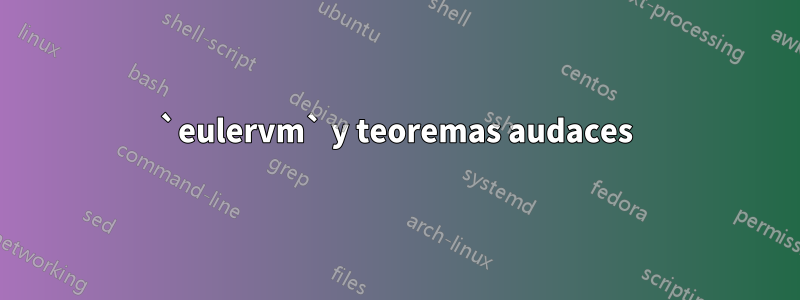
Yo uso concrete-romancomo en Knuth.Matemáticas Concretascomo mi fuente principal. Sin embargo, no viene con una fuente matemática, así que eulervmla incluyo.
\usepackage{amsmath,amssymb,amsthm}
\usepackage{concrete}% the concrete-roman, used in concrete mathetics
\usepackage{eulervm}% the math fonts used in concrete mathematics
Esto ha ido bien hasta que intenté reforzar mis teoremas. Es decir, en lugar de
Teorema 4.1. 1+1 = 2
Quiero
Teorema 4.1.1+1 = 2.
Para esto, agregué el siguiente comando a la copia del encabezado desde ¿Cómo poner en negrita el título opcional de un teorema con amsthm?
\newtheoremstyle{mystyle}% % Name
{}% % Space above
{}% % Space below
{}% % Body font
{}% % Indent amount
{\bfseries}% % Theorem head font
{.}% % Punctuation after theorem head
{.5em}% % Space after theorem head, ' ', or \newline
{\thmname{#1}\thmnumber{ #2}\thmnote{ (#3)}}% % Theorem head spec (can be left empty, meaning `normal')
\theoremstyle{mystyle}
\numberwithin{equation}{subsection}
\newtheorem{theorem}[equation]{Theorem}
No funciona.
Si elimino eulervm, los teoremas se ponen en negrita. Sin embargo, las fuentes recurren a algunas predeterminadas.
Pregunta
¿Cómo puedo permanecer en el país de concrete+eulervmlas fuentes, con teoremas en negrita?
posiblemente relacionado
Se señala enMatemáticas audaces en eulervmque eulervmmaneja las fuentes en negrita de manera diferente. Pero solo abordaron fuentes matemáticas en negrita.
Ejemplo mínimo
A continuación se muestra un ejemplo mínimo que se compila con $ pdflatex. Puede alternar eulervmpara ver los efectos descritos en mi pregunta. Observe que mystyleefectivamente está funcionando: al desactivarla \theoremstyle{mystyle}se cambia la fuente del cuerpo a cursiva (predeterminada).
\documentclass[15pt]{article}
\usepackage[margin=1in]{geometry}
\usepackage[utf8]{inputenc}
\usepackage{amsmath,amssymb,amsthm}
\usepackage{concrete}% the concrete-roman, used in concrete mathetics
\usepackage{eulervm}% the math fonts used in concrete mathematics
\newtheoremstyle{mystyle}% % Name
{}% % Space above
{}% % Space below
{}% % Body font
{}% % Indent amount
{\bfseries}% % Theorem head font
{.}% % Punctuation after theorem head
{.5em}% % Space after theorem head, ' ', or \newline
{\thmname{#1}\thmnumber{ #2}\thmnote{ (#3)}}% % Theorem head spec (can be left empty, meaning `normal')
\theoremstyle{mystyle}
\newtheorem{theorem}[equation]{Theorem}
\begin{document}
\begin{theorem}
The sum of $1$ and $1$ is $2$.
\end{theorem}
\end{document}
Respuesta1
Después de investigar un poco en los archivos de descripción de fuentes, encontré la razón por la que las sustituciones en negrita no funcionaban. Concrete no viene en negrita y el paquete de fuentes solo declara una sustitución de la /bx/nserie y la forma en la T1codificación. De forma predeterminada, estaba intentando /b/nutilizar OT1.
Por lo tanto, puede reemplazar el comando
\usepackage{concrete}
con
\usepackage[T1]{fontenc}
\usepackage{ccfonts}
\renewcommand\bfdefault{bx}
te recomendaría usarunicode-math LuaLaTeX donde puedas, y fuentes heredadas de 8 bits cuando sea necesario. Veresta respuestapara varios ejemplos más largos.
Dado que está definiendo su propio estilo de teorema, puede seleccionar la fuente de su elección para sus encabezados, como, aquí, Latin Modern Sans-Serif Semi-bold Condensed:
\documentclass[15pt]{article}
\usepackage[margin=1in]{geometry}
\usepackage[T1]{fontenc}
\usepackage[utf8]{inputenc} % The default since 2018
\usepackage{amsmath,amssymb,amsthm}
\usepackage{bm}
\usepackage{ccfonts}% the concrete-roman, used in concrete mathetics
\usepackage{eulervm,eucal,eufrak}% the math fonts used in concrete mathematics
\renewcommand\bfdefault{bx}
\newtheoremstyle{mystyle}% % Name
{}% % Space above
{}% % Space below
{}% % Body font
{}% % Indent amount
{\usefont{T1}{lmss}{sbc}{n}}% % Theorem head font
{.}% % Punctuation after theorem head
{.5em}% % Space after theorem head, ' ', or \newline
{\thmname{#1}\thmnumber{ #2}\thmnote{ (#3)}}% % Theorem head spec (can be left empty, meaning `normal')
\theoremstyle{mystyle}
\newtheorem{theorem}[equation]{Theorem}
\begin{document}
\begin{theorem}
The sum of $1$ and $1$ is $2$.
\end{theorem}
\end{document}


